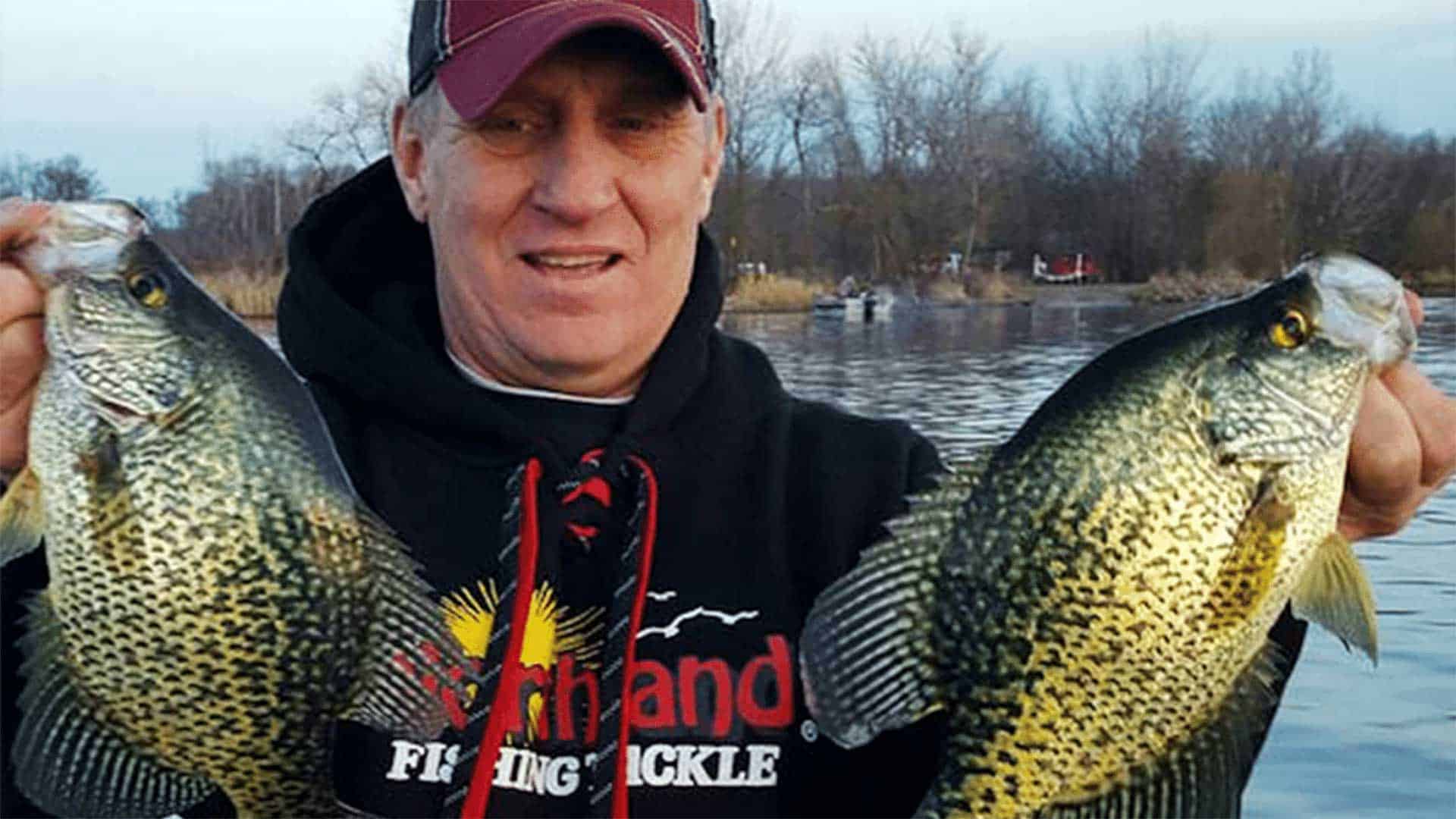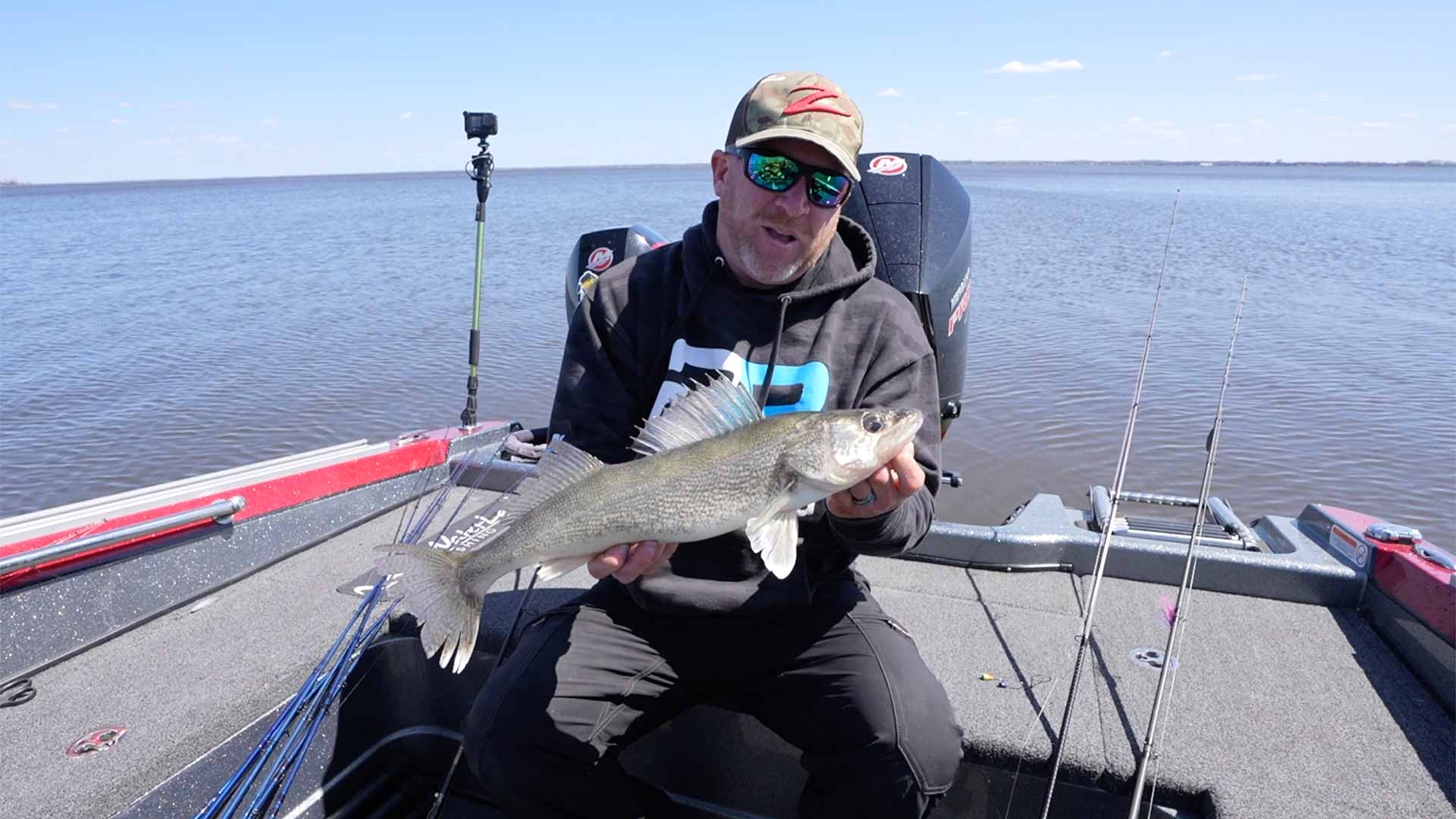Early spring is prime time to catch ice-out crappies. Chances are, you will find them somewhere between their wintering haunts and the areas where they will eventually spawn later in the spring. To help you fully take advantage of this fabulous fishing opportunity, we reached out to six of the top pros in the Upper Midwest and asked them one simple question:
What’s Your Strategy for Ice-Out Crappies?

Brian Brosdahl – Bro’s Guide Service
I catch some of my biggest crappies of the year just after ice-out. Now is a great time to be out on the chase. The first thing I key in on this time of year is warm water areas. This could be in the mud, the north end of bays (on most lakes), creek beds, low-lying bays, boat harbors, canals or anything that leads to a shallow flat. Shallow mud can be extremely important because it will absorb the sun’s rays and will often be several degrees warmer than other parts of the lake. Vegetation is limited right now because most of it died throughout the winter, so green sprouting or surviving weeds are great spots to look. If you can’t find any plant life, try to find wood. Old log piles, trees hanging in the water, and beaver chews and beaver dams are all great spots to look for spring crappies. Other places you can look are dock structures and underneath boats and pontoons. Depending on the lake, you might have a lot of success around dead weeds that don’t give off toxins like wild rice, cane, canary grass or even old hard stem rushes that meet soft bottom areas.
One thing to remember no matter where you’re looking: Crappies tend to gravitate towards the holes. If there’s any kind of deeper spots in the area you’re fishing, they will likely be there holding to structure. Water clarity is something to keep in mind, too. In clear water, big crappies will be reluctant to go too shallow unless you’re out during low light conditions or a cloudy day.
I like to use a bobber in these situations for a few reasons. First of all, the added weight of the bobber allows you to cast small crappie baits a good bit further. More importantly, bobbers allow you the ability to vary your retrieve in such a way to catch more fish. You can impart action into your bait by hopping the bobber or simply tipping it over. The biggest advantage of using a bobber vs retrieving a bobber-less jig is that you can pause your bait without it falling into the mud or cover you’re fishing around. It’s a good way to keep your bait clean. Some of my favorite baits this time of year are Hexi Flies or Bro Bugs tipped with waxies. I also love feather jigs or any kind of pulsating jigs like the Gypsy Jig or a Fire-Fly Jig.

Cory Schmidt – Traditions Media
Something extra special about those first crappie runs of the spring. Couple ways to approach it: Lots of folks hike into small backwater channels, bays or canals. Grab a single rod, fill a backpack with a few jigs, plastics and slip floats and you’re be all set. The fishing in these spots is usually boom or bust. But when the crappies come in as water temps climb into the low to mid 50s, you can waylay several dozen fish in short order. Some of my favorite baits here are micro ice fishing plastics, especially little wormy things with fine, active tails, worked gently beneath a slip float.
The other approach is to hop in your boat and locate some of the first stands of pondweed or elodea (waterweed). Crappies are already using these little vegetation patches at ice out, and the best ones usually lie just inside or just outside shallow bays. Often, the new plants are no more than a foot in height, but it’s enough cover to attract and hold a lot of fish.
Side imaging sonar is an awesome way to locate these patches, which usually lie in 6 to 12 feet of water. Some are on flats, others along drop-offs. In clear lakes on calm days, you can sunglass the shallows and spot the patches—dark spots on otherwise light sand bottoms. You can also locate the spots at late ice, because many times, the crappies will be on these very same patches before and just after ice out. Casting little white or black 1/16- or 1/32-ounce tube jigs on 3-pound test mono and a 6-1/2 or 7-foot light spinning rod is easy, effective and as fun as it gets.

Gord Pyzer – Fishing Editor & Biologist
Being hot blooded lovers that find bathtub temperatures irresistible, pre-spawn crappies are always looking for the warmest water they can find, so search for them with this in mind. The best places to start are where you know they will eventually be spawning in a few weeks time – green pencil reeds, flooded brush, fallen trees, sprouting beds of cabbage and isolated shallow rock piles.
Now, systematically move away from these areas keeping your eyes glued to the water temperature reading on your sonar screen. Indeed, at this time of the year, marking a school of crappies on your sonar screen is a secondary bonus. What you’re really looking for is the warmest water you can find. And you’ll usually stumble upon it in the south-facing bays, coves, and indentations that warm up first, along the north shore of the lake.
Even a one or two-degree temperature difference is important, so concentrate your search for early spring crappie where you find the warmest water.

Joel Nelson – Rapala Pro
In many years, good crappie bites can be tracked by the calendar, but with an early spring you’ll have to pay closer attention to water temperature. As black-bottom bays and rock-laden shorelines store what solar energy they can, crappies flood to the shallows as water temps hit 45 degrees and above. In most of the lakes I fish, this seems to be as close to a “magic number” as I can find in helping to predict not only locations, but mood of the crappies I’m after. Anything south of that value, and shallow water crappies become much more rare and hard to find.
Regarding location, cover is king for pre-spawn crappies. While any wood or timber is good for finding them, brush is better. An isolated log or stump may hold a few fish, but large concentrations of fish will be found where they can bury themselves within and along brush piles. Unfortunately, most anglers miss the bonanza by fishing only around the edges, rather than within the heavy cover. Fish with floats, and use meat. Crappies are carnivorous little beings, and you’ll be surprised how savagely they’ll strike a minnow offered on a VMC Hot Skirt Jig in sizes up to 1/16 oz. This larger profile requires some aggression, and hookups seem much more sure as crappies are required to fully inhale such a presentation. Plastics bites are still to come, but typically require warmer conditions yet. It’s unfortunate that minnows are best fished when your freezing fingers would otherwise want you to use artificials-only, but it seems like warm weather and glove-less hands are about the best predictor on when to start looking to retrieved plastic presentations. For this reason, bring bait until steadily retrieved jig/plastic combinations out-perform more stationary live-bait options.

Mike Frisch – Fishing the Midwest
This is going to sound simple, but the first thing I do when I’m looking for ice-out crappies is go to a lake that I know has a good population of them. If you want to get on a good bite, you need to ditch the lakes and areas that WERE good and start going to the places that ARE good. As far as location goes, the classic dark-bottom bays, the marinas, the boat canals; those kinds of places are great, but I always advise anglers not to forget about the mid-depth areas leading into the shallows. This is where the fish will hold before they make those feeding runs when the weather stabilizes. Now is when you’re going to find a lot of crappies hanging out in that deeper water because the weather this time of year can be very unstable.
My key presentation for this fishing situation is the bread-and-butter slip-bobber setup with a jig and a crappie minnow. One of my favorite jigs for this is Northland’s Gypsy Jig with it’s tinsel tail. Lately, I’ve been having more and more success throwing soft plastics for spring crappies. One of my go-to baits during the winter is an Impulse Mini Smelt, which is a minnow imitator that darts and glides in the water. I’m starting to have a lot of success with that bait now during the spring. If the fish are really finicky, they may still want meat, but on days when they are really active, you can catch just as many if not more on plastics and you don’t need to spend time re-baiting minnows.
There’s one thing that I should probably mention: I don’t let my slip-bobber rig sit in place for very long, especially when I’m fishing plastics. I’ll let it settle in, pop it, twitch it, maybe reel it along slowly, and let it settle back in. Many people think of bobber fishing as stationary, but it doesn’t need to be. You can effectively search through an area pretty quickly by fan casting.
Bonus Info!
Hungry for more early-season crappie information? — Check out our “Crappies Early Season Bobber Tactics” video, where Dan Lindner and Jeremy Smith dig into this topic even further. If water temperatures in your area are already approaching 60F degrees, reading Dave Csanda’s article “Spawning Crappies and Bluegills” should be very helpful.









